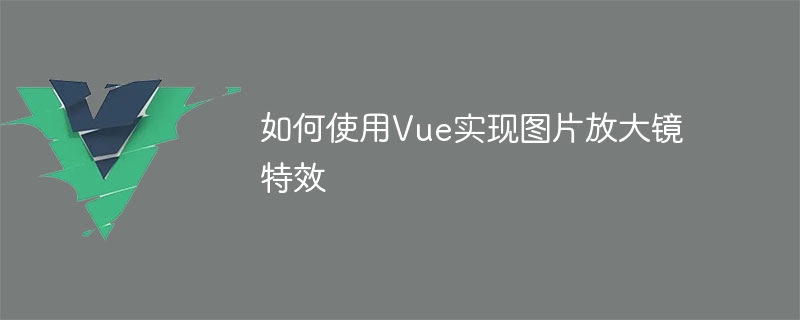Vue を使用して画像の虫眼鏡効果を実装する方法

Vue を使用して画像拡大鏡効果を実装する方法
はじめに:
インターネット技術の継続的な発展に伴い、画像は私たちの日常生活においてますます重要な役割を果たしています。命の大切な役割。ユーザーエクスペリエンスと視覚効果を向上させるために、画像拡大鏡効果はWebデザインで広く使用されています。この記事では、Vue フレームワークを使用して単純な画像の虫眼鏡効果を実装する方法と、具体的なコード例を紹介します。
1. 準備:
始める前に、Vue フレームワークが正しくインストールされ、Vue プロジェクトが作成されていることを確認してください。
2. コンポーネント設計:
Vue のコンポーネント化のアイデアを使用して、画像の拡大鏡効果を実現します。コンポーネントにより、コードの再利用性と保守性が向上します。この例では、2 つのコンポーネントを作成する必要があります。
- MainImage コンポーネント (MainImage):
このコンポーネントは、元の画像を表示し、マウス移動イベントをリッスンして虫眼鏡の位置を計算します。コード例は以下のとおりです。
<template>
<div class="main-image">
<img src="/static/imghw/default1.png" data-src="imageSrc" class="lazy" : ref="mainImg" @mousemove="onMouseMove" @mouseenter="onMouseEnter" @mouseleave="onMouseLeave" alt="Vue を使用して画像の虫眼鏡効果を実装する方法" >
<div class="magnifier" v-if="showMagnifier" :style="{backgroundImage: 'url(' + imageSrc + ')', backgroundPosition: bgPos}"></div>
</div>
</template>
<script>
export default {
props: {
imageSrc: {
type: String,
required: true
}
},
data() {
return {
showMagnifier: false,
bgPos: '',
}
},
methods: {
onMouseMove(e) {
const img = this.$refs.mainImg;
const rect = img.getBoundingClientRect();
const x = e.clientX - rect.left;
const y = e.clientY - rect.top;
const bgPosX = x / img.offsetWidth * 100;
const bgPosY = y / img.offsetHeight * 100;
this.bgPos = `${bgPosX}% ${bgPosY}%`;
},
onMouseEnter() {
this.showMagnifier = true;
},
onMouseLeave() {
this.showMagnifier = false;
}
}
}
</script>
<style>
.main-image {
position: relative;
}
.main-image img {
max-width: 100%;
}
.magnifier {
position: absolute;
z-index: 99;
width: 200px;
height: 200px;
border: 1px solid #ccc;
background-repeat: no-repeat;
}
</style>- サムネイルコンポーネント(Thumbnail):
サムネイルの一覧を表示し、サムネイルをクリックすることでメイン画像を切り替えるコンポーネントです。コード例は次のとおりです:
<template>
<div class="thumbnail">
<div v-for="image in thumbnailList" :key="image" @click="onThumbnailClick(image)">
<img src="/static/imghw/default1.png" data-src="image" class="lazy" : alt="thumbnail">
</div>
</div>
</template>
<script>
export default {
data() {
return {
thumbnailList: [
'https://example.com/image1.jpg',
'https://example.com/image2.jpg',
'https://example.com/image3.jpg'
],
currentImage: ''
}
},
methods: {
onThumbnailClick(image) {
this.currentImage = image;
}
}
}
</script>
<style>
.thumbnail {
display: flex;
}
.thumbnail img {
width: 100px;
height: 100px;
margin-right: 10px;
cursor: pointer;
}
</style>3. ページ レイアウト:
この例では、メイン画像コンポーネントとサムネイル コンポーネントをルート コンポーネントに導入し、それぞれ props に渡す必要があります。 . 画像のアドレス。以下は簡単なページ レイアウトの例です:
<template>
<div class="wrapper">
<main-image :imageSrc="currentImage"></main-image>
<thumbnail></thumbnail>
</div>
</template>
<script>
import MainImage from './MainImage.vue';
import Thumbnail from './Thumbnail.vue';
export default {
components: {
MainImage,
Thumbnail
},
data() {
return {
currentImage: ''
}
},
mounted() {
// 设置默认的主图地址
this.currentImage = 'https://example.com/defaultImage.jpg';
}
}
</script>
<style>
.wrapper {
display: flex;
justify-content: space-between;
align-items: center;
}
</style>概要:
上記のコード例を通じて、Vue フレームワークを使用して単純な画像の虫眼鏡効果を実装する方法を確認できます。メイン画像コンポーネントは元画像の表示とマウス移動イベントの処理を担当し、サムネイルコンポーネントはサムネイル一覧の表示とメイン画像の切り替えを担当します。これら 2 つのコンポーネントを組み合わせてルート コンポーネントに導入すると、画像拡大鏡の効果を実現できます。この記事が、Vue を使用して画像の拡大鏡効果を実現する方法を理解するのに役立つことを願っています。
注: 上記のコード例は簡略化されたバージョンであり、実際の使用中に特定のニーズに応じて調整および拡張する必要がある場合があります。
以上がVue を使用して画像の虫眼鏡効果を実装する方法の詳細内容です。詳細については、PHP 中国語 Web サイトの他の関連記事を参照してください。

ホットAIツール

Undresser.AI Undress
リアルなヌード写真を作成する AI 搭載アプリ

AI Clothes Remover
写真から衣服を削除するオンライン AI ツール。

Undress AI Tool
脱衣画像を無料で

Clothoff.io
AI衣類リムーバー

AI Hentai Generator
AIヘンタイを無料で生成します。

人気の記事

ホットツール

メモ帳++7.3.1
使いやすく無料のコードエディター

SublimeText3 中国語版
中国語版、とても使いやすい

ゼンドスタジオ 13.0.1
強力な PHP 統合開発環境

ドリームウィーバー CS6
ビジュアル Web 開発ツール

SublimeText3 Mac版
神レベルのコード編集ソフト(SublimeText3)

ホットトピック
 7513
7513
 15
15
 1378
1378
 52
52
 78
78
 11
11
 19
19
 64
64
 VUEのボタンに関数を追加する方法
Apr 08, 2025 am 08:51 AM
VUEのボタンに関数を追加する方法
Apr 08, 2025 am 08:51 AM
HTMLテンプレートのボタンをメソッドにバインドすることにより、VUEボタンに関数を追加できます。 VUEインスタンスでメソッドを定義し、関数ロジックを書き込みます。
 VueでBootstrapの使用方法
Apr 07, 2025 pm 11:33 PM
VueでBootstrapの使用方法
Apr 07, 2025 pm 11:33 PM
vue.jsでBootstrapを使用すると、5つのステップに分かれています。ブートストラップをインストールします。 main.jsにブートストラップをインポートしますブートストラップコンポーネントをテンプレートで直接使用します。オプション:カスタムスタイル。オプション:プラグインを使用します。
 vue.jsでJSファイルを参照する方法
Apr 07, 2025 pm 11:27 PM
vue.jsでJSファイルを参照する方法
Apr 07, 2025 pm 11:27 PM
vue.jsでJSファイルを参照するには3つの方法があります。タグ;; mounted()ライフサイクルフックを使用した動的インポート。 Vuex State Management Libraryを介してインポートします。
 VueでWatchの使用方法
Apr 07, 2025 pm 11:36 PM
VueでWatchの使用方法
Apr 07, 2025 pm 11:36 PM
Vue.jsの監視オプションにより、開発者は特定のデータの変更をリッスンできます。データが変更されたら、Watchはコールバック関数をトリガーして更新ビューまたはその他のタスクを実行します。その構成オプションには、すぐにコールバックを実行するかどうかを指定する即時と、オブジェクトまたは配列の変更を再帰的に聴くかどうかを指定するDEEPが含まれます。
 Vueによる前のページに戻る方法
Apr 07, 2025 pm 11:30 PM
Vueによる前のページに戻る方法
Apr 07, 2025 pm 11:30 PM
vue.jsには、前のページに戻る4つの方法があります。$ router.go(-1)$ router.back()outes&lt; router-link to =&quot;/&quot; Component Window.history.back()、およびメソッド選択はシーンに依存します。
 Vueはマーキー/テキストスクロール効果を実現します
Apr 07, 2025 pm 10:51 PM
Vueはマーキー/テキストスクロール効果を実現します
Apr 07, 2025 pm 10:51 PM
CSSアニメーションまたはサードパーティライブラリを使用して、VUEでマーキー/テキストスクロール効果を実装します。この記事では、CSSアニメーションの使用方法を紹介します。スクロールテキストを作成し、テキストを&lt; div&gt;をラップします。 CSSアニメーションを定義し、オーバーフローを設定します:非表示、幅、アニメーション。キーフレームを定義し、アニメーションの開始と終了時にtranslatex()を設定します。期間、スクロール速度、方向などのアニメーションプロパティを調整します。
 Vueのバージョンを照会する方法
Apr 07, 2025 pm 11:24 PM
Vueのバージョンを照会する方法
Apr 07, 2025 pm 11:24 PM
Vue Devtoolsを使用してブラウザのコンソールでVueタブを表示することにより、Vueバージョンを照会できます。 NPMを使用して、「NPM List -G Vue」コマンドを実行します。 package.jsonファイルの「依存関係」オブジェクトでVueアイテムを見つけます。 Vue CLIプロジェクトの場合、「Vue -Version」コマンドを実行します。 &lt; script&gt;でバージョン情報を確認してくださいVueファイルを参照するHTMLファイルにタグを付けます。
 Vue Multi-Page開発とはどういう意味ですか?
Apr 07, 2025 pm 11:57 PM
Vue Multi-Page開発とはどういう意味ですか?
Apr 07, 2025 pm 11:57 PM
VUEマルチページ開発は、VUE.JSフレームワークを使用してアプリケーションを構築する方法です。アプリケーションは別々のページに分割されます。コードメンテナンス:アプリケーションを複数のページに分割すると、コードの管理とメンテナンスが容易になります。モジュール性:各ページは、簡単に再利用および交換するための別のモジュールとして使用できます。簡単なルーティング:ページ間のナビゲーションは、単純なルーティング構成を介して管理できます。 SEOの最適化:各ページには独自のURLがあり、SEOに役立ちます。




